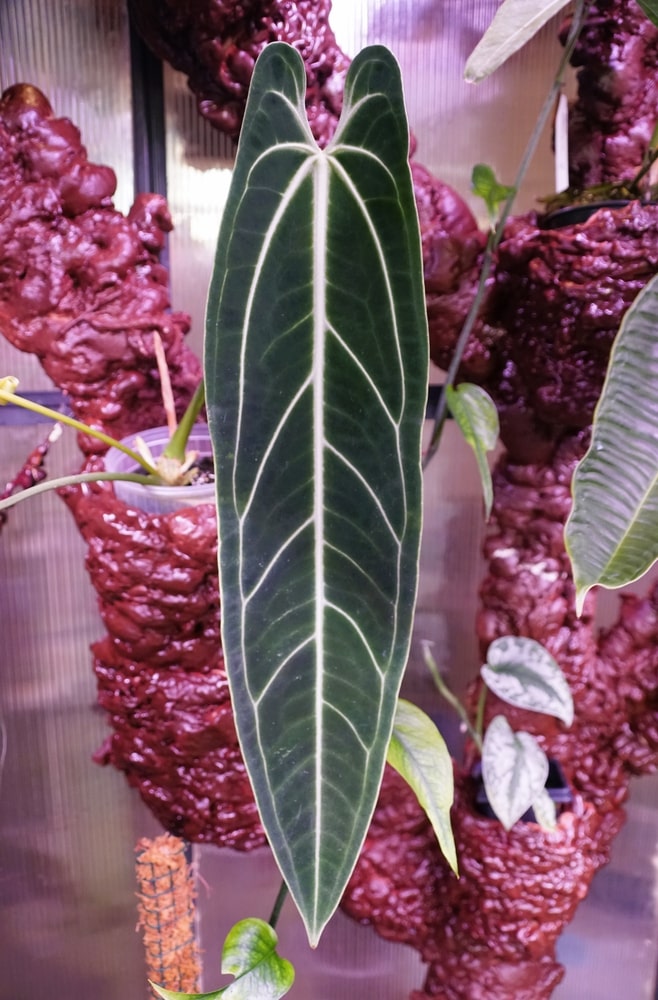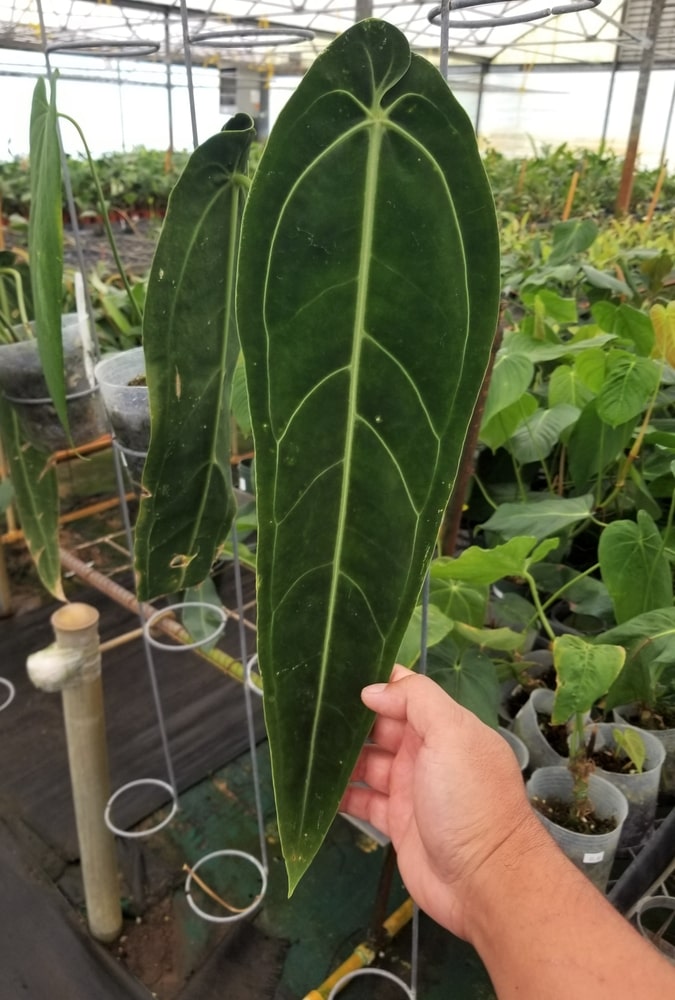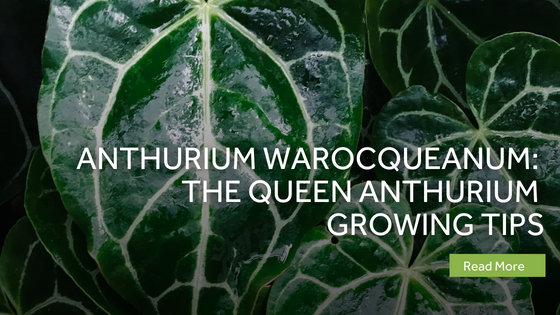If you are looking for a beautiful yet spunky tropical plant, the Anthurium warocqueanum, or Queen Anthurium, may be right for you. This Arum is an epiphytic plant sporting vibrant, dark green leaves with white veins. The Queen anthurium is far pickier than other plants regarding its care, so read on and become an expert!
Table of Contents
Anthurium Warocqueanum & Queen Anthurium Overview
The Anthurium warocqueanum is a perennial climber in the Araceae family. This species prefers a specific range for watering, temperature, soil, and humidity and is far pickier than its cousins. This tropical plant originates from tropical rainforests in central and western Colombia and enjoys conditions similar to its natural habitat.
The Anthurium warocqueanum is also called the Queen anthurium and is named after the famed Belgian plant lover M. Waroque. Additionally, this plant is an epiphyte, which is found growing on other plants in its habitat.
Other plants in the Anthurium genus and relatives to the Queen anthurium include the Anthurium crystallinum, Anthurium veitchii, and the Anthurium andreanum.
Anthurium crystallinum: this Anthurium variety bears beautiful heart-shaped leaves with white veins and dark green leaves.
Anthurium veitchii: often referred to as the “King of the Anthuriums” due to the sheer size of the green leaves with ridged veins.
Anthurium andreanum: This variety of Anthurium is also called the flamingo plant due to its vibrant reddish-pink colored bracts.
| Botanical Name | Anthurium warocqueanum |
| Family | Araceae |
| Genus | Anthurium |
| Origin | Colombia |
| Sunlight | Bright indirect light |
| Watering | Moderate, about once per week |
| Soil | Loose, well-draining, rich soil |
| Temperature | 60-85 degrees Fahrenheit |
| Propagation | Stem cutting division |
| Re-Potting | Every two to three years, or once rootbound in the pot |
| Pests and Diseases | Aphids, mealy bugs, spider mites, scale, and thrips |
| Toxicity | Toxic to humans and pets |

Queen Anthurium Warocqueanum Plant Features
In nature, the Anthurium warocqueanum plant can grow to massive heights using other plants as a support structure. However, as an indoor plant, the height and spread are much smaller scale.
Indoors, the Queen Anthurium often grows to be about three feet tall. The real magnificence of this species is the stunning dark green, white-veined, and droopy leaves. The leaves on this plant grow up to four feet in length at maturity and are about two to three feet wide. It is common for Queen anthurium plants to only have a few leaves on the plant at a time.
Upon reaching maturity, the Anthurium warocqueanum will produce flowers but rarely fruit. This is because female flowers are produced first, then the males. Since they are not around simultaneously, pollination cannot occur in producing fruits.
The Anthurium warocqueanum is toxic to humans and pets due to oxalate crystals and is deer and rabbit resistant.
Anthurium Warocqueanum & Queen Anthurium Care Guide
The Queen Anthurium is a tropical plant and prefers an environment similar to its natural habitat. This means your Anthurium warocqueanum prefers bright indirect light and higher temperature and humidity levels.
The Anthurium warocqueanum is often planted indoors in a pot or hanging basket, the latter being similar to how it naturally grows in the rainforest. Be sure to plant with rich, well-draining soil and take time to learn its habits with watering.
The Queen anthurium has a growing season in spring and summer and has dormancy in the fall and winter. Read on to learn more about the Anthurium warocqueanum care requirements.
Ideal Growing Place
The Anthurium warocqueanum can be planted both indoors and outdoors. If planting outdoors, ensure that your area’s climate is suitable for this cooler temperature-sensitive plant. Planting indoors allows more control over the environment your Queen Anthurium is exposed to.
The growing season for the Anthurium warocqueanum is in the warmer spring and summer months, and dormancy follows in the cooler fall and winter. This species can be planted in pots, hanging baskets, and other plant containers indoors or outdoors.
Water
One of the trickier parts of Anthurium warocqueanum care is learning your plant’s watering pattern. The Queen anthurium is native to tropical regions and is used to receiving heavy rain that does not linger around the roots. Since we cannot often replicate this, we must figure out a watering pattern that works for our plant.
A good place to start is watering your Anthurium warocqueanum about once a week. It is essential that your plant has well-draining, rich soil like sphagnum moss or orchid mix to help hold in some water, but not too much, which can cause root rot.
If your plant is unhappy with how much water it receives, the leaves will give you a clue with yellowing. As you learn your plant’s preferences, check the soil moisture often to avoid letting the soil become too dry.
Sunlight
The Anthurium warocqueanum prefers bright, indirect light. If your Queen Anthurium is an indoor plant, the light from a north-facing window is excellent and not too strong. If your plant is outdoors, plant in a shady area that still receives that indirect light. Too much direct sunlight can harm your dark green velvety leaves by scorching them. Tropical plants experience this in their natural habitat, with many other plants growing over them.
Temperature
Anthurium plants grow best in environments of 65-80 degrees Fahrenheit. Being a tropical plant, Anthurium warocqueanum can withstand the warmer temperatures but is extremely sensitive to temperatures in the 50s or below, which can cause stress and trauma to the plant.
Soil
Epiphytes like the Anthurium warocqueanum grow on supporting surfaces like other plants and trees. However, because of their growing method, their roots are exposed. Because of this, the Queen anthurium roots dry out quickly when exposed to water in the wild and can draw up nutrients from the air and debris passing by.
When planting this species, it is best to use a loose, well-draining, and rich soil with materials like sphagnum moss, peat moss, and coarse bark. This soil mixture allows air and water to pass through and prevent issues like root rot.
Humidity
Hailing from tropical regions like Colombia, the Anthurium warocqueanum thrives best in high humidity environments. Therefore, 70% humidity or higher is best for Anthurium warocqueanum care. A humidifier can help keep humidity levels indoors consistent but ensure adequate air circulation to avoid excess moisture resting on your leaves. Too much-resting water on leaves can lead to harmful bacterial infections or fungal issues.
Fertilizer
A slow-release fertilizer or liquid fertilizer at one-fourth strength is recommended to provide your Anthurium warocqueanum with enough nutrients. Feed your Queen anthurium about once a week to ensure it is getting enough extra strength to grow.
Some warning signs indicating your plant needs more nutrients include one leaf dying to make room and nutrients available to a new one or browning of the leaves. Check your Anthurium warocqueanum care as a whole to rule out other possibilities for these symptoms.
Pinching/Pruning
Damage can occur to the beautiful and large leaves of your Queen anthurium either through wear and tear of moving and people or through bacterial or fungal disease. Trimming off the damaged leaves with sterilized shears is the best way to prune your plant to keep it healthy.
Potting and Re-potting
It may be time to repot your Anthurium warocqueanum every two to three years or when root growth surpasses the current pot size. When it is time, find a larger home for your plant, whether it be a terra cotta pot, wooden basket, orchid basket, or another plant container. It is best for the container or pot to have drainage holes to allow excess water to pass through and allow air circulation.
The best time to repot your plant is in the spring, when new growth occurs rapidly, not in the dormant fall and winter months. To help further support new growth, ensure the new pot has a fresh soil mixture and is moist.
Growth Zone
Due to the specific Anthurium warocqueanum care requirements, this species is only best suited to grow outdoors in the USDA Plant Hardiness Zones 10-11. This region encompasses western parts of California, Oregon, and Washington, and the southernmost states from Arizona to Florida.
Common Pests, Toxins, Diseases & Other Problems
The main pests affecting your Queen anthurium include spider mites, mealy bugs, aphids, scale, and thrips. These pests use your plant to feed and suck nutrients from it. This can be treated by plant oil sprays and wiping down your plant’s leaves.
Additionally, the Anthurium warocqueanum is susceptible to bacterial and fungal diseases caused by too much water sitting on the large leaves. This can be avoided by having good air circulation in your plant’s environment.
Propagation
Anthurium warocqueanum propagation is done through division. Other plant propagation methods use stem cuttings, but Anthurium propagation is made easier by using buds on the plant’s main stem that produce around one to two leaves at first. To propagate, follow these steps.
- Locate a main stem bud with one to two leaves and aerial roots
- Cut the bud from the mother plant with sterilized shears or a sharp knife at the roots
- Place this new plant cutting into a pot or basket with fresh sphagnum moss
- Place in a humid and warm area, and give it a fresh watering
Queen Anthurium Warocqueanum Mature Timeline
Day 1-21: the cutting grows in the new pot or basket and establishes roots and leaf growth.
Day 21+: care for your Queen anthurium as recommended above.

Anthurium Warocqueanum & Queen Anthurium FAQ
Is Anthurium Warocqueanum Toxic to Cats, Dogs, and Humans?
Anthurium warocqueanum is toxic to humans and pets due to oxalate crystals in the plant, which can cause mouth irritation, nausea, vomiting, and diarrhea.
Is Anthurium Warocqueanum Queen Rare?
Due to being endemic to Colombia, this plant cannot naturally be found growing in other places in the world. Additionally, this species is not often cultivated.
Why Is My Anthurium Warocqueanum Dying?
There are various reasons your Anthurium warocqueanum is dying, such as improper use of watering, soil substrate, temperature, and sunlight. Pests and diseases may also be harming your plant. Look to your plant’s leaves as another indicator of what is going wrong.
Why Does My Plant Loose Leaves?
Anthurium warocqueanum plants tend to discard their leaves when not receiving proper care, especially on the watering front. Ensure that temperature, soil substrate, humidity, and fertilizer are in the recommended range.
Why Are the Leaves on My Anthurium Warocqueanum Turn Yellow?
Sometimes leaves on your Anthurium warocqueanum plant turn yellow naturally due to age, but more likely, it is because of improper watering, soil, nutrient deficiency, or stress on the plant.
Should I Mist My Anthurium Warocqueanum & Queen Anthurium?
Misting is a great way to provide additional humidity to your Anthurium warocqueanum. This species thrives in a humidity-rich environment of about 70%.
Where Is There a Queen Anthurium Warocqueanum for Sale?
The Queen anthurium warocqueanum plant is hard to come by in stores and can be purchased online at specialty nursery sites or larger e-commerce sites like Etsy.
Why Are Anthuriums So Expensive?
Anthuriums can be quite expensive due to their rarity, shipping costs, and extensive care they require to grow to a size ready to sell to customers.
What’s Unique About Anthurium Warocqueanum?
Anthurium warocqueanum plants show many unique features like their velvety dark green leaves, white veins, and massive leaves. The rarity of this plant is also a key feature adding to its value.
How to Identify Anthurium Warocqueanum?
You can identify this species by its dark green velvety leaves with white veins, massive leaf size, and aerial roots.
How to Grow Anthurium Warocqueanum Indoors?
Follow the care guide above to grow the Anthurium warocqueanum plant indoors successfully. This plant requires bright indirect light, 65-80 degrees Fahrenheit temperatures, high humidity, and well-draining, rich soil.
How to Grow Anthurium Warocqueanum Outdoors?
To grow outdoors successfully, ensure your area is in zones 10-11 in the USDA Plant Hardiness Zone Map, and follow the care guide above.
How Fast Does Anthurium Warocqueanum Grow?
In just a few years, the Anthurium warocqueanum plant can grow around 4 feet in height indoors. The growing season is during spring and summer.
How to Make Anthurium Warocqueanum Grow Faster?
During spring and summer, the Queen anthurium goes through rapid growth and can be supported using fertilizer to give extra nutrients. Be sure not to give more than the recommended amount, as this can lead to excess salt buildup. You can further support your plant’s growth rate by providing adequate water, light, and soil.
How Tall Does Anthurium Warocqueanum Grow?
Indoors, the average height of the Anthurium warocqueanum is around three feet tall. However, this plant can grow on trees and other plants to reach massive heights in the wild.
How to Stake Anthurium Warocqueanum?
The best way to support your Anthurium warocqueanum plant is to place it in a wooden orchid basket to support the growing plant and its roots.
How to Revive Anthurium Warocqueanum?
Since the Queen anthurium is picky about its conditions, several things can harm your plant’s health. To revive it, check that you follow the recommended watering, soil, temperature, humidity, and light requirements. Then, rule out each one until your plant responds.
Why Is My Anthurium Warocqueanum Drooping?
Drooping or wilting leaves can signify that your plant is fighting a bacterial or fungal infection. Be sure to avoid water resting on the large leaves as this is a significant cause of infection.
Is Anthurium Warocqueanum Hard to Grow?
Anthurium warocqueanum is more complex to care for than the typical house plant, but by following the care requirements, this plant can thrive indoors and outdoors.
The Bottom Line
If you are looking for a large-leaved velvety plant to add some color to your space, the Anthurium warocqueanum is right for you. Once you know your plant and its requirements, you will have a beautiful tropical plant that will succeed under your care.
Last Updated on August 31, 2022 by Gustaf Johansson




